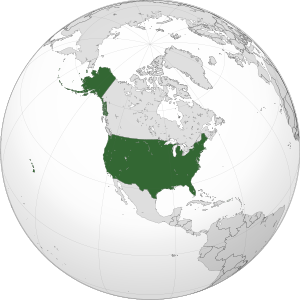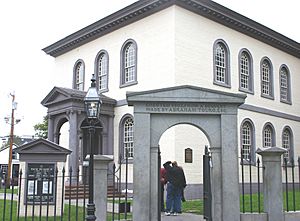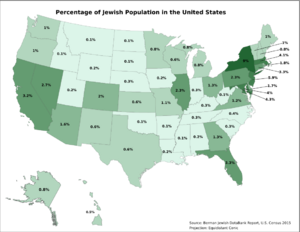History of the Jews in the United States facts for kids
Jewish communities have been a part of the United States since the first European settlers arrived. At first, many Jewish people came from Spain and Portugal, settling in cities like Charleston, South Carolina, which was once the largest Jewish community in North America. Later, in the 1800s and early 1900s, many Jewish immigrants arrived from Europe. For example, German Jews came in the mid-1800s and started clothing stores across the country. They also created Reform synagogues and were important in banking in New York.
Later, between 1880 and 1914, a large number of Ashkenazi Jews who spoke Yiddish arrived from Eastern Europe. Many settled in New York City. They became very active in labor movements and brought new forms of Judaism, like Orthodox and Conservative Judaism.
After the Holocaust in Europe, more Jewish refugees came to the U.S. After 1970, many also arrived from the Soviet Union. American Jews have often been involved in politics, usually supporting the Democratic Party. They are known for having high levels of education and for moving up in society. While small Jewish communities have become smaller, more Jewish people now live in large cities.
In the 1940s, Jewish people made up about 3.7% of the U.S. population. By 2019, there were about 7.1 million Jewish people, which is 2% of the total population. The biggest Jewish communities are in the areas around New York (2.1 million), Los Angeles (617,000), Miami (527,750), Washington, D.C. (297,290), Chicago (294,280), and Philadelphia (292,450).
Contents
- Jewish Immigration to the U.S.
- Early Jewish Life in America (Colonial Era)
- Revolutionary War Era
- Jewish Life in the 1800s
- Mass Immigration (1880–1925)
- Local Jewish Communities (1600s to 1900s)
- Jewish Involvement in Social Change
- Becoming American
- Giving Back to the Community
- World War I
- The 1930s and World War II
- After World War II
- Local Jewish Communities (20th and 21st Centuries)
- Growing Success in the 1900s
- Jewish Life Today
- Antisemitism in the United States
- Images for kids
- See also
Jewish Immigration to the U.S.
The Jewish population in the U.S. grew because of many waves of immigration, mostly from Europe. People came seeking new chances and to escape hatred and danger in their home countries. Very few returned to Europe, though some moved to Israel later.
In 1790, there were only about 1,000 to 2,000 Jewish residents, mostly Sephardi Jews from Great Britain and the Dutch Republic. By 1840, this number grew to about 15,000, and by 1880, it reached about 250,000. Most Jewish immigrants in the mid-1800s were Ashkenazi Jews from German-speaking areas. They often spoke German and settled across the country, fitting in with other Americans. Many became traders and opened clothing stores.
Between 1880 and 1914, about 2 million Yiddish-speaking Ashkenazi Jews came from Eastern Europe. They were fleeing violent attacks called pogroms. They came from places like Russia, Poland, and Ukraine. Many settled in New York City, where they helped create the clothing industry and were active in trade unions.
These new immigrants from Eastern and Southern Europe were different from earlier immigrants from Northern and Western Europe. This led to some people wanting to limit immigration. Laws like the Emergency Quota Act of 1921 and the Immigration Act of 1924 put strict limits on who could come to the U.S. These limits stayed in place until 1965.
Jewish immigrants quickly built support networks, including many small synagogues and groups for people from the same hometowns. Leaders encouraged them to become part of American culture, and they quickly did. During World War II, about 500,000 American Jews served in the military. After the war, many Jewish families moved to the suburbs, became wealthier, and traveled more. Jewish communities grew in cities like Los Angeles and Miami.
The Holocaust in Europe, which destroyed most of the Jewish community there by 1945, made the United States home to the largest Jewish population outside of Israel. In 1900, there were 1.5 million American Jews; by 2005, there were 5.3 million.
Today, American Jews belong to different Jewish groups, or denominations. The most common are Reform Judaism, Conservative Judaism, and Orthodox Judaism. However, about 25% of American Jews don't belong to any specific group.
Early Jewish Life in America (Colonial Era)
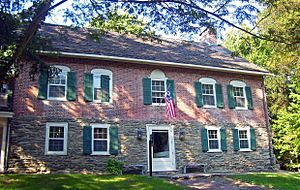
The first Jewish person to arrive in what is now the U.S. was Joachim Gans in 1584. In 1621, Elias Legarde, a Sephardic Jew from France, arrived in Virginia to teach people how to grow grapes for wine.
In September 1654, a group of 23 Jews from Brazil arrived in New Amsterdam (now New York City). The governor, Peter Stuyvesant, tried to make them leave, but his bosses in the Netherlands, who believed in religious freedom, told him to let them stay. In 1664, the English took over New Amsterdam and renamed it New York.
Religious freedom was also important in other colonies. The colony of South Carolina allowed all settlers, including Jews, to practice their religion freely. Because of this, Charleston, South Carolina had a large Jewish community. Sephardic Jews also settled early in Newport, Rhode Island (home to the Touro Synagogue, America's oldest synagogue building), Savannah, Philadelphia, and Baltimore. In New York City, the Shearith Israel Congregation is the oldest Jewish community, started in 1687.
Revolutionary War Era
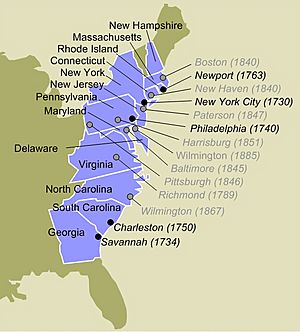
By 1776, when the American Revolutionary War began, about 2,000 Jews lived in the colonies. Most were Sephardic Jews from the Netherlands, Great Britain, and the Iberian Peninsula. Many American Jews supported the fight for independence. Some joined the army, like Francis Salvador, who was the first American Jew killed in the war. Businessman Haym Salomon helped raise money for the army.
After the war, U.S. President George Washington recognized the contributions of Jewish people. In a letter to the Jewish community in Newport, Rhode Island, in 1790, he wrote about how everyone should be able to live safely and freely.
In 1790, Jewish people faced some laws that stopped non-Christians from holding public office or voting in certain states. However, states like Delaware, Pennsylvania, South Carolina, and Georgia quickly removed these barriers. The U.S. Bill of Rights in 1791 also helped ensure religious freedom for everyone. This move towards equality helped prevent widespread hatred against Jews in America, unlike in Europe.
Jewish Life in the 1800s
In the early 1800s, Jewish communities in the U.S. began to organize. They set up an orphanage in Charleston, South Carolina, in 1801, and the first Jewish school in New York in 1806. In 1843, the first national Jewish organization, the B'nai B'rith, was founded.
By 1840, Jewish people were a small but stable middle-class group of about 15,000 out of 17 million Americans. However, as more immigrants arrived, the Jewish population grew to 50,000 by 1848. With this growth, negative ideas about Jewish people appeared more often in newspapers and popular culture, and physical attacks became more common.
During the 1840s and 1850s, most Jewish immigrants were Ashkenazi Jews from Germany. They brought new ideas from the Jewish Enlightenment, called the Haskalah. It was in the U.S. during this time that two major branches of Judaism were formed by these German immigrants: Reform Judaism and Conservative Judaism.
Civil War and Jewish Involvement
During the American Civil War, about 3,000 Jews fought for the Confederate side and 7,000 for the Union. Jewish people also held leadership roles. Nine Jewish generals served in the Union Army, and many Jewish officers fought for both sides. Judah P. Benjamin, a Jewish man, served as Secretary of State for the Confederacy.
In December 1862, General Ulysses S. Grant issued an order to expel Jews from areas under his control, blaming them for illegal trade. Jewish people appealed to President Abraham Lincoln, who immediately canceled the order. This event showed that Jewish people could fight against unfair treatment and win, strengthening their community.
Jewish People in Politics
Jewish people also started to become more involved in politics. The first Jewish member of the United States House of Representatives, Lewis Charles Levin, and Senator David Levy Yulee, were elected in 1845.
After becoming president in 1869, Ulysses S. Grant regretted his wartime order. He made an effort to support Jewish people, appointing more of them to public office than any previous president. He also helped Jewish people who were being treated unfairly in Russia and Romania. Grant's actions helped Jewish people gain more respect and equality in America.
Jewish Banking Firms
In the mid-1800s, several German Jews started important investment banking firms. These included Goldman Sachs, Kuhn Loeb, Lehman Brothers, Salomon Brothers, and Bache & Co.. These firms became very important in the financial world.
Moving West
In the 1800s, Jewish people began settling across the American West. Many started as peddlers before opening stores. For example, Levi Strauss started a wholesale clothing business and in 1873, he created the first blue jeans, which became very popular. In the West, Jewish people were generally accepted with little discrimination.
Jewish women also played a big part in building Jewish communities in the West. For instance, the first synagogue in Arizona, Temple Emanu-El in Tucson, was started by a local Jewish women's group. Many Jewish leaders became important in local and state politics. By the 1900s, Los Angeles became the second-largest Jewish center in the U.S., with Jewish producers playing a big role in the Hollywood film industry.
Mass Immigration (1880–1925)
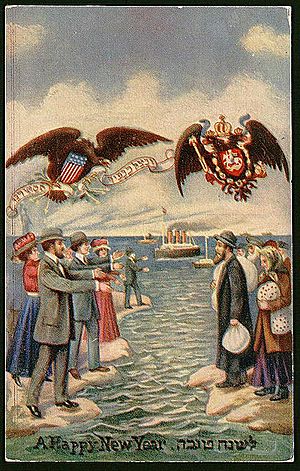
Between the late 1800s and early 1900s, a huge number of Jewish people moved from Eastern and Southern Europe to the United States. About 2.8 million European Jews came during this time, mostly from Eastern Europe, fleeing violence and seeking better opportunities.
Many of these immigrants arrived on the East Coast, but some came through the Galveston Movement and settled in Texas and other Western states. By 1915, Yiddish newspapers in New York City alone had a circulation of half a million copies. Yiddish theater was also very popular and helped train performers who later moved to Hollywood.
Limiting Immigration (1924-1965)
By 1924, 2 million Jews had arrived from Central and Eastern Europe. However, growing anti-immigration feelings in the U.S. led to the Immigration Act of 1924, which greatly limited immigration from many regions, including Eastern Europe. The Jewish community strongly opposed these limits. In the 1930s, they tried hard to allow Jewish refugees from Nazi Germany to enter, but with little success. These restrictions remained until 1965.
Local Jewish Communities (1600s to 1900s)
Chicago, Illinois
The first Jewish people in Chicago were Ashkenazi. In the late 1830s and early 1840s, German Jews arrived, many becoming street peddlers or opening stores that grew into larger businesses. In the early 1900s, more Ashkenazi Jews came, escaping violence in Eastern Europe.
Oakland, California
Jewish people were important pioneers in Oakland in the 1850s. The Oakland Hebrew Benevolent Society, founded in 1862, was the community's religious and social center. The first synagogue, the First Hebrew Congregation of Oakland, was founded in 1875. Most Jews in Oakland were from Poland and worked in the clothing industry. Jewish women's groups also did a lot of charity work for both Jewish and non-Jewish people.
When Jewish refugees from a fire in San Francisco came to Oakland, the synagogue provided immediate help, offering food, clothing, and shelter to hundreds of people.
New Orleans, Louisiana
Jewish people were not allowed in French Louisiana until 1803. In the 1830s, Abraham Cohen Labatt helped start the first Jewish community in Louisiana. Many Jewish immigrants opened businesses, like Leon Godchaux's clothing store in 1844. In 1870, the city's wealthy German Jews founded Temple Sinai, the first Reform synagogue in New Orleans.
New York City, New York
In 1654, the first group of Jews came as refugees from Brazil to New Amsterdam, which became New York City. Over the years, German, Sephardic, and Ashkenazi Jews continued to arrive, playing a big part in the city's history. In the late 1800s and early 1900s, a wave of Ashkenazi Jews fleeing violence in Eastern Europe came to the city. This made New York's Jewish population over 1 million in 1910, the largest Jewish population in any city at that time.
San Francisco, California
Jewish people formed a community in San Francisco during the California Gold Rush (1848–1855). Levi Strauss, who founded the company that makes blue jeans, and Harvey Milk, a famous activist and politician, were well-known Jewish San Franciscans.
Jewish Involvement in Social Change
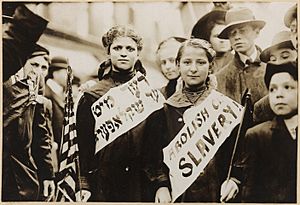
Many Jewish immigrants from Central and Eastern Europe were interested in labor and socialist movements. Jewish newspapers like Forwerts often had a socialist viewpoint. Groups like The Workmen's Circle were important in Jewish community life.
Jewish Americans were involved in almost every major social movement. They were leaders in promoting workers' rights, civil rights, women's rights, religious freedom, and peace. They also fought against prejudice.
Becoming American
The process of new immigrants quickly adapting to American culture, called Americanization, was very important to the established German Jews. Jacob Schiff, a wealthy German Jew, helped Eastern European Jews and fought against immigration limits. He believed that American Jews could be part of both Jewish and American worlds, creating a strong Jewish community in the U.S.
The National Council of Jewish Women (NCJW), founded in 1893, helped new Jewish women immigrants with housing, health, and jobs. They also taught English and helped women keep their Jewish identity. The NCJW continued to fight against strict immigration laws after World War I.
Giving Back to the Community
Since the 1820s, organized charity has been a core value for American Jews. In most cities, Jewish charitable groups are at the heart of the community. A lot of money now goes to Israel, as well as to hospitals and universities. In the past, it went to help poor Jewish people. This meant that wealthy German Reform Jews helped support poor Orthodox newcomers, helping them become Americanized and bridging cultural differences.
Julius Rosenwald (1862–1932) was a famous Jewish philanthropist. He helped turn a small company called Sears, Roebuck into the largest retailer in America. He used his wealth to help rural Black communities, building over 5,000 public schools for Black children. He also gave a lot of money to the NAACP and the University of Chicago.
World War I
During World War I, Jewish Americans had different feelings about the war. Many Yiddish-speaking Jews supported Zionism, which aimed to create a Jewish state. However, established German-American Jews were mostly against it. From 1914 to 1916, few Jewish people wanted the U.S. to join the war. Many saw the British government as unfriendly to Jewish interests. New York City, with its large Jewish community, was a center for anti-war activities.
Jewish people were especially concerned about the Russian government, which was known for allowing violent attacks against Jews. When the Russian government fell in March 1917, a major reason for many Jews not supporting the war was removed.
About 250,000 Jews served in the American military during World War I, which was more than their share of the general population. The American Jewish community also raised $63 million to help victims of the war in Europe.
The 1930s and World War II
Many Eastern European Jews who arrived after 1880 were more liberal or left-leaning in their politics. They became the majority political voice among Jewish Americans. Many had experience in socialist movements and helped found unions in the clothing industry. These unions played a big role in the CIO and in Democratic Party politics.
By the 1930s, Jewish people were a major political force in New York City, strongly supporting the liberal programs of the New Deal. They also strongly supported the Civil Rights Movement. However, by the mid-1960s, the Black Power movement caused some separation between Black and Jewish groups, though both remained mostly Democratic.
In Washington, D.C., 15% of President Roosevelt's appointees were Jewish, including important positions like Secretary of the Treasury, Henry Morgenthau Jr., and Supreme Court Justice Felix Frankfurter. Roosevelt's policies aimed to create economic opportunities for working-class people.
In the 1930s, hatred against Jewish people in the U.S. grew. This led to informal limits on Jewish Americans in universities, certain jobs, and housing. Many universities limited the number of Jewish students they accepted. Law firms hired fewer Jewish lawyers, and hospitals gave fewer patients to Jewish doctors. High-end communities often had rules that prevented Jewish Americans from buying homes there.
Refugees from Nazi Germany
Between 1934 and 1943, the U.S. government and public were concerned about the fate of Jews in Europe but generally refused to allow large numbers of Jewish refugees to immigrate. The U.S. accepted only 21,000 refugees from Europe and did not fill its immigration quotas. This was partly due to economic problems and high unemployment in the U.S., but also because of growing antisemitism.
The MS St. Louis
The SS St. Louis sailed from Germany in May 1939 with 936 Jewish refugees. On June 4, 1939, President Roosevelt refused to let the ship unload its passengers in the U.S. because of immigration laws and strong public opposition. The ship had to return to Europe. Of the passengers, only 365 survived the Holocaust.
Immigration Limits During the Holocaust
The U.S.'s strict immigration policies were not changed during the Holocaust, even as news of the terrible events reached the U.S. in 1941 and 1942. It's believed that 190,000 to 200,000 Jews could have been saved if not for these obstacles. Asylum for European Jews was not a top priority for the U.S. during the war.
After World War II
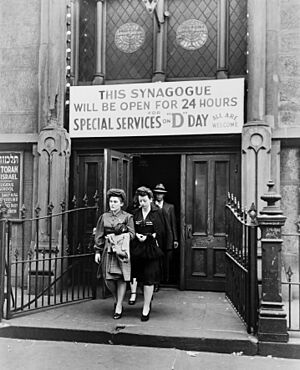
About 500,000 American Jews fought in World War II. After the war, many young families moved to the suburbs. There, Jewish people became more integrated into American culture, and the number of marriages between Jewish and non-Jewish people increased. Jewish school enrollment more than doubled after the war, and synagogue membership jumped from 20% in 1930 to 60% in 1960.
Because the U.S. was not affected by the Holocaust, it became the largest and strongest center of Judaism in the world after World War II. Smaller Jewish communities around the world looked to American Jews for help.
After the war, some Jewish refugees settled in the U.S. Another wave of Jewish refugees from Arab nations also came to the U.S. after being forced out of their home countries.
Politics After the War
American Jews mostly voted for Democrats like Franklin D. Roosevelt and Harry S. Truman in the 1940s. This strong support for Democrats continued for many decades. For example, in 1964, 90% of American Jews voted for Lyndon B. Johnson.
In 2000, Connecticut Senator Joe Lieberman became the first Jewish person to be a vice presidential candidate for a major party. In 2016, Bernie Sanders became the first Jewish American to win a U.S. presidential primary election.
American Jewish Identity
Historians believe that American Jewish history is special because of the great freedom, acceptance, and success Jewish people found here. This allowed them to combine their Jewish identity with being American more easily than Jews in Europe.
After 1960, memories of the Holocaust and the Six-Day War in 1967 (when Israel survived a major conflict) had a big impact on shaping Jewish identity. These events gave Jewish people a reason to keep their unique identity at a time when other minority groups were also celebrating their heritage.
Creation of Israel
When the State of Israel was created in 1948, it became a very important focus for American Jewish life and charity. It became a symbol that united American Jews.
The Six-Day War
The Six-Day War in June 1967 was a turning point for many Jewish people. The fear of another Holocaust, followed by Israel's surprising victory, deeply affected American Jews. Their financial support for Israel increased greatly after the war.
Civil Rights Movement
Jewish people were strong supporters of the American Civil Rights Movement. They were very visible as leaders fighting for civil rights for all Americans, including themselves and African Americans. Many Jewish leaders spoke at important marches, like the March on Washington in 1963 and the Selma-to-Montgomery march.
While most Jewish people supported the civil rights movement, some worried about how it might affect Jewish communities in the South. Despite this, Jewish people were very involved in the movement. However, relations between African Americans and Jews have sometimes been difficult due to differences in neighborhoods and social class, especially in big cities.
Jewish Feminism
The modern Jewish feminist movement began in the early 1970s in the U.S. Early Jewish feminists wanted women to be included in prayer groups, to have equal religious duties, and to have equal rights in Jewish law, such as in divorce. Sally Priesand became America's first female rabbi in 1972.
Immigration from the Soviet Union
The last large wave of Jewish immigration came from the Soviet Union after 1988. After the 1967 Six-Day War, the Soviet Union made it harder for Jews to get an education or jobs. This led to a group called 'refuseniks' – Jews who were denied permission to leave. The U.S. government put pressure on the Soviet Union to allow these Jews to emigrate.
Many of these immigrants first went to Vienna, Austria, and then to Israel. After 1976, most chose to resettle in the West, often in the U.S. American Jewish organizations helped them get visas and settle in the U.S.
Today, the Russian Jewish population in the U.S. is the second largest after Israel. Large Russian-Jewish communities can be found in Brooklyn, New York (especially Brighton Beach), Sunny Isles Beach in South Florida, Northeast Philadelphia, and Northern New Jersey.
Local Jewish Communities (20th and 21st Centuries)
Nashville, Tennessee
In the first half of the 1900s, Reform Jews, mostly German, became the largest Jewish community in Nashville. They had good relationships with Orthodox and Conservative groups. Some German Jewish refugees settled in Nashville from 1935 to 1939. By 1949, Jewish communities had moved to the suburbs. While some social discrimination existed, Nashville's Jews were respected by the larger community.
Palm Springs, California
About 32,000 Jews live in the Palm Springs area. Many older American Jews from the East Coast and Los Angeles move here to retire in the warm climate. By the 1990s, they made up a large part of the population. There are 12 Jewish places of worship, including a Jewish community center in Palm Desert.
Palm Springs has an annual "Winter Festival of Lights" parade, which started as a separate Chanukah parade in the 1960s. Over time, it combined with the Christmas parade to celebrate the lights of the season.
Miami
After 1945, many Jewish people from the Northeast moved to Florida, especially to Miami and nearby cities. They found familiar foods and better weather. They formed more open communities, where people were less focused on strict traditions.
Princeton, New Jersey
Jewish student life at Princeton University has greatly improved since World War II. In 1961, Princeton's first kosher kitchen, Yavneh House, was established. In 1971, a university-managed kosher eating facility opened. This progress was due to both Jewish student efforts and the university's openness.
Beverly Hills, California
About 20-25% of the population in this wealthy Los Angeles suburb is Jewish. About a quarter of the members of Sinai Temple, a big synagogue in nearby Westwood, are Persian Jews.
New York City
As of 2016, New York state has about 1.8 million Jewish people, with 1.1 million living in New York City.
Growing Success in the 1900s
In 1983, economist Thomas Sowell noted that Jewish family incomes were the highest of any large ethnic group in the U.S., 72% above the national average. He pointed out that the quick rise in social and economic status for Jewish people in America was unique.
Historian Edward S. Shapiro mentioned that in the 1980s, over 100 of the 400 richest Americans were Jewish, which was nine times more than expected based on their population size. He also estimated that over 30% of American billionaires are Jewish.
In the past, very few Jewish lawyers were hired by big, traditional law firms. So, they started their own. By 1965, six of the 20 largest law firms in New York City were Jewish. By the 1990s, Jewish people became important in Congress and state governments across the country.
Jewish Life Today
| Year | % Jewish |
|---|---|
| 1790 | 0.04% |
| 1800 | 0.04% |
| 1810 | 0.04% |
| 1820 | 0.03% |
| 1830 | 0.05% |
| 1840 | 0.09% |
| 1850 | 0.22% |
| 1860 | 0.48% |
| 1870 | 0.52% |
| 1880 | 0.51% |
| 1890 | 0.64% |
| 1900 | 1.39% |
| 1910 | 1.93% |
| 1920 | 3.20% |
| 1930 | 3.43% |
| 1940 | 3.61% |
| 1950 | 3.30% |
| 1960 | 2.99% |
| 1970 | 2.89% |
| 1980 | 2.51% |
| 1990 | 2.22% |
| 2000 | 1.97% |
| 2010 | 1.76% |
Note: These charts are for the U.S. core Jewish population only. 1810 is an estimate as exact figures are not available for this year.
American Jews continued to do well in the early 21st century. A 2016 study found that Jewish people were the most financially successful religious group in the U.S. Many Jewish people are leaders in business, universities, and politics. About 30% of American Nobel Prize winners in science are Jewish.
However, studies also show that some Jewish people live in or near poverty. The percentage of Jewish students at Ivy League Universities has also decreased.
The Jewish population in the U.S. is not growing much. As Jewish Americans have become more integrated into American culture, there are more marriages between Jewish and non-Jewish people. This means the population has stayed steady or even shrunk, while the country's overall population has grown.
Politically, most Jewish people remain strongly liberal and vote for the Democratic Party.
Jewish Identity Today
Historians often describe American Jewish identity as an "ethnic" one. This means it includes both religious and non-religious Jewish experiences. After 1960, memories of the Holocaust and the survival of Israel in the Six-Day War greatly influenced Jewish identity. These events gave Jewish people a strong reason to keep their unique ethnic identity.
Antisemitism in the United States
Hatred against Jewish people has existed in the U.S. In the 1900s, Jewish people faced discrimination in jobs, social clubs, resorts, and housing. Universities also limited the number of Jewish students they accepted. In response, Jewish people created their own clubs, resorts, and universities, like Brandeis.
Antisemitism was at its highest in the U.S. between World War I and World War II. Groups like the Ku Klux Klan and figures like Henry Ford and Father Charles Coughlin spread anti-Jewish messages.
Physical violence against Jews has been rare in the U.S., but some notable cases include attacks in New York City in 1902, the lynching of Leo Frank in 1915, and the Crown Heights riot of 1991.
After World War II and the Civil Rights Movement, anti-Jewish feelings decreased. However, some Black nationalist groups accused Jews of exploiting Black workers. Surveys show that African Americans are more likely to hold antisemitic beliefs than white Americans, but education helps reduce these beliefs across all groups.
In recent years, there have been some increases in antisemitic incidents, including vandalism and threats. For example, in 2014, a former Ku Klux Klan member murdered three people at a Jewish center in Kansas City. There have also been cases of swastikas drawn on Jewish property and the spread of antisemitic flyers.
A 2015 survey found that 54% of Jewish students on college campuses had experienced or witnessed antisemitism. Most of these incidents came from other students. In 2017, there were nearly 50 bomb threats made to Jewish community centers across the country.
Images for kids
Private residence (22%) College campus (7%) Jewish institution / school (11%) Non-Jewish school (12%) Public area (35%) Private building / area (12%) Cemetery (1%)
See also
 In Spanish: Historia de los judíos en Estados Unidos para niños
In Spanish: Historia de los judíos en Estados Unidos para niños


